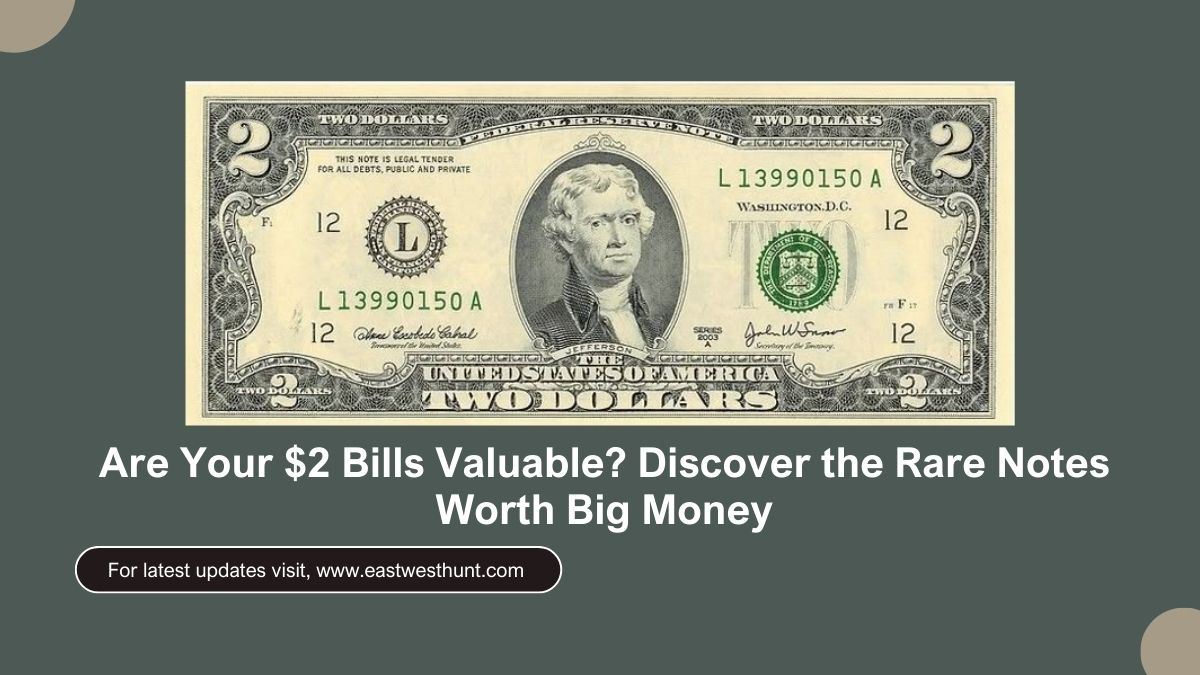Many people think of $2 bills as being uncommon, but not particularly valuable. However, for currency collectors, certain $2 bills are worth far more than their face value. Thanks to factors like age, rarity, misprints, and special serial numbers, these bills can sell for thousands of dollars. In this article, we’ll explore the history of the $2 bill, the rarest $2 bills worth the most money, and how to spot a valuable bill. If you’re lucky enough to own one, it might be worth much more than you think!
History of the $2 Bill
The $2 bill has been a part of U.S. currency for over 160 years, even though it’s rarely used in everyday transactions. Throughout its history, the $2 bill has undergone several changes in design, and each change has made certain versions more valuable to collectors. Below are some of the key moments in the history of the $2 bill:
- 1862: The first $2 bill was issued, featuring Alexander Hamilton’s portrait.
- 1869: A redesign was introduced, featuring a portrait of Thomas Jefferson.
- 1928: The $2 bill was made smaller in size, with a red Treasury seal.
- 1966: Printing of the $2 bill was stopped due to low usage.
- 1976: The $2 bill was reintroduced as a commemorative bill for the 200th anniversary of the Declaration of Independence.
Despite being rare in everyday circulation, the $2 bill is still printed today. Many people believe it is no longer in production, which makes it a sought-after item for collectors.
Which $2 Bills Are Worth the Most Money?
Although most $2 bills appear similar, some are worth a lot more because of unique features. The following $2 bills are among the most valuable:
- 1862 and 1869 $2 Bills
- Value: $2,800 – $3,800 in uncirculated condition.
- Why They’re Valuable: These early bills are rare and historically significant.
- 1890 Treasury Note
- Value: $4,500 or more at auction.
- Why They’re Valuable: These bills were backed by gold or silver, making them highly rare.
- 1928 Red Seal $2 Bill
- Value: Circulated: $5 – $175, Uncirculated: $1,000+.
- Why They’re Valuable: The first small-sized $2 bill, with a red Treasury seal, is an important part of U.S. currency history.
- 1976 Bicentennial $2 Bill
- Value: Regular versions: $2 – $20, Rare serial numbers: Up to $900, Ladder notes: Thousands of dollars.
- Why They’re Valuable: Special serial numbers and misprints make some 1976 bills extremely valuable.
Features That Increase the Value of $2 Bills
Not all $2 bills are worth more than face value. To determine how valuable your bill might be, consider the following factors:
Year of Issue
Older bills, especially those printed before 1928, tend to be more valuable. Bills from the 1800s or early 1900s are rare and highly collectible.
Condition
A bill in uncirculated condition—one that has no folds, creases, or stains—is worth much more. A bill that has been heavily circulated will not be as valuable.
Seal Color
The color of the seal on the bill can affect its value:
- Red Seal: More valuable than bills with a green seal.
- Blue Seal: These are silver certificates and can be worth more.
- Green Seal: These are usually worth face value unless they have unique serial numbers or misprints.
Unique Serial Numbers
Some serial numbers make a bill more valuable:
- Ladder Notes: Serial numbers that are in perfect sequence (e.g., 12345678).
- Radar Notes: Numbers that read the same forwards and backwards (e.g., 1234321).
- Low Serial Numbers: Bills with very low serial numbers, like 00000005, are highly collectible.
Printing Errors or Misprints
Bills with misaligned seals, double prints, or duplicate serial numbers are much rarer and therefore more valuable.
Common vs. Rare $2 Bills
Here’s a simple comparison of common and rare $2 bills:
| Feature | Common $2 Bills | Rare & Valuable $2 Bills |
|---|---|---|
| Year of Issue | 1976 or later | Pre-1928 or limited prints |
| Condition | Circulated, worn | Uncirculated, graded |
| Seal Color | Green | Red or blue |
| Serial Number | Random numbers | Special sequences (ladder, radar) |
| Errors or Misprints | None | Misaligned seals, duplicate serials |
Where to Sell Rare $2 Bills
If you own a rare $2 bill and want to sell it, there are several places where you can find buyers:
- Online Auctions: Websites like eBay or Heritage Auctions allow you to sell to a wide range of collectors, ensuring competitive prices.
- Currency Dealers: Professional dealers can assess the value of your bill and help you get a fair price.
- Collector Events & Expos: These events allow you to meet buyers directly and may lead to better offers.
- Online Marketplaces: Websites like Etsy, Facebook Marketplace, or Craigslist let you sell your bills privately, but prices can vary widely.
Hidden Value of Your $2 Bills: 7 Key Factors That Could Make You Rich
Rare $2 bills can be surprisingly valuable. If you’re a collector, there’s a good chance that your $2 bills could be worth thousands. By understanding the factors that increase their worth—like age, condition, unique serial numbers, and misprints—you can spot hidden treasures in your collection. Always research and evaluate your bills before selling to make sure you’re getting the highest possible value.
FAQs
How much are 1928 Red Seal $2 Bills worth?
These bills can range from $5 for circulated notes to over $1,000 for uncirculated ones.
What makes a $2 bill worth more than face value?
Age, condition, unique serial numbers, and misprints can increase the value of a $2 bill significantly.
Where is the best place to sell a rare $2 bill?
You can sell rare $2 bills through online auctions, currency dealers, or collector events for the best prices.
Must Visit: East West Hunt
